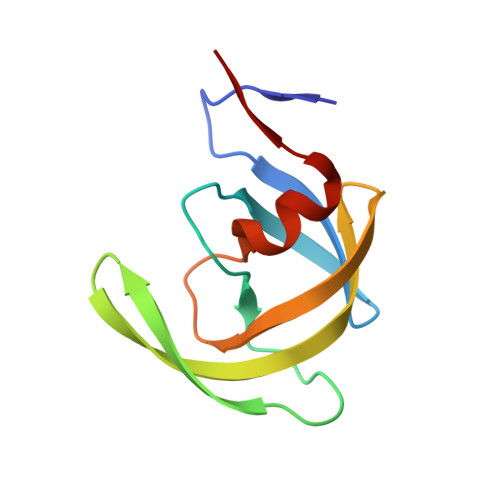Kinetic, stability, and structural changes in high-resolution crystal structures of HIV-1 protease with drug-resistant mutations L24I, I50V, and G73S.
Liu, F., Boross, P.I., Wang, Y.F., Tozser, J., Louis, J.M., Harrison, R.W., Weber, I.T.(2005) J Mol Biol 354: 789-800
- PubMed: 16277992
- DOI: https://doi.org/10.1016/j.jmb.2005.09.095
- Primary Citation of Related Structures:
2AVM, 2AVO, 2AVQ, 2AVS, 2AVV - PubMed Abstract:
The crystal structures, dimer stabilities, and kinetics have been analyzed for wild-type human immunodeficiency virus type 1 (HIV-1) protease (PR) and resistant mutants PR(L24I), PR(I50V), and PR(G73S) to gain insight into the molecular basis of drug resistance. The mutations lie in different structural regions. Mutation I50V alters a residue in the flexible flap that interacts with the inhibitor, L24I alters a residue adjacent to the catalytic Asp25, and G73S lies at the protein surface far from the inhibitor-binding site. PR(L24I) and PR(I50V), showed a 4% and 18% lower k(cat)/K(m), respectively, relative to PR. The relative k(cat)/K(m) of PR(G73S) varied from 14% to 400% when assayed using different substrates. Inhibition constants (K(i)) of the antiviral drug indinavir for the reaction catalyzed by the mutant enzymes were about threefold and 50-fold higher for PR(L24I) and PR(I50V), respectively, relative to PR and PR(G73S). The dimer dissociation constant (K(d)) was estimated to be approximately 20 nM for both PR(L24I) and PR(I50V), and below 5 nM for PR(G73S) and PR. Crystal structures of the mutants PR(L24I), PR(I50V) and PR(G73S) were determined in complexes with indinavir, or the p2/NC substrate analog at resolutions of 1.10-1.50 Angstrom. Each mutant revealed distinct structural changes relative to PR. The mutated residues in PR(L24I) and PR(I50V) had reduced intersubunit contacts, consistent with the increased K(d) for dimer dissociation. Relative to PR, PR(I50V) had fewer interactions of Val50 with inhibitors, in agreement with the dramatically increased K(i). The distal mutation G73S introduced new hydrogen bond interactions that can transmit changes to the substrate-binding site and alter catalytic activity. Therefore, the structural alterations observed for drug-resistant mutations were in agreement with kinetic and stability changes.
Organizational Affiliation:
Department of Biology, Molecular Basis of Disease Program, Georgia State University, Atlanta, GA 30303, USA.



















